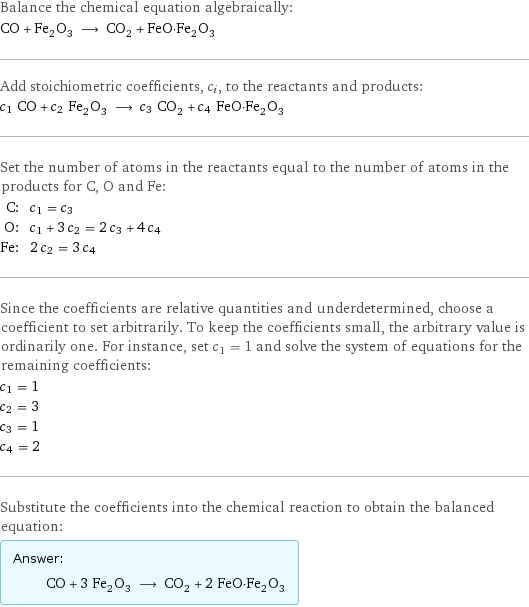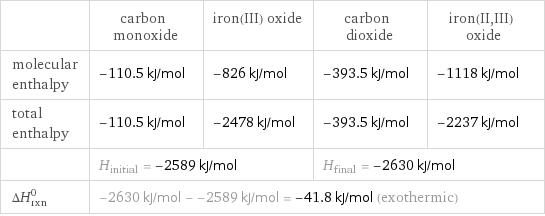Input interpretation

CO (carbon monoxide) + Fe_2O_3 (iron(III) oxide) ⟶ CO_2 (carbon dioxide) + FeO·Fe_2O_3 (iron(II, III) oxide)
Balanced equation

Balance the chemical equation algebraically: CO + Fe_2O_3 ⟶ CO_2 + FeO·Fe_2O_3 Add stoichiometric coefficients, c_i, to the reactants and products: c_1 CO + c_2 Fe_2O_3 ⟶ c_3 CO_2 + c_4 FeO·Fe_2O_3 Set the number of atoms in the reactants equal to the number of atoms in the products for C, O and Fe: C: | c_1 = c_3 O: | c_1 + 3 c_2 = 2 c_3 + 4 c_4 Fe: | 2 c_2 = 3 c_4 Since the coefficients are relative quantities and underdetermined, choose a coefficient to set arbitrarily. To keep the coefficients small, the arbitrary value is ordinarily one. For instance, set c_1 = 1 and solve the system of equations for the remaining coefficients: c_1 = 1 c_2 = 3 c_3 = 1 c_4 = 2 Substitute the coefficients into the chemical reaction to obtain the balanced equation: Answer: | | CO + 3 Fe_2O_3 ⟶ CO_2 + 2 FeO·Fe_2O_3
Structures

+ ⟶ +
Names

carbon monoxide + iron(III) oxide ⟶ carbon dioxide + iron(II, III) oxide
Reaction thermodynamics
Enthalpy

| carbon monoxide | iron(III) oxide | carbon dioxide | iron(II, III) oxide molecular enthalpy | -110.5 kJ/mol | -826 kJ/mol | -393.5 kJ/mol | -1118 kJ/mol total enthalpy | -110.5 kJ/mol | -2478 kJ/mol | -393.5 kJ/mol | -2237 kJ/mol | H_initial = -2589 kJ/mol | | H_final = -2630 kJ/mol | ΔH_rxn^0 | -2630 kJ/mol - -2589 kJ/mol = -41.8 kJ/mol (exothermic) | | |
Gibbs free energy

| carbon monoxide | iron(III) oxide | carbon dioxide | iron(II, III) oxide molecular free energy | -137 kJ/mol | -742.2 kJ/mol | -394.4 kJ/mol | -1015 kJ/mol total free energy | -137 kJ/mol | -2227 kJ/mol | -394.4 kJ/mol | -2031 kJ/mol | G_initial = -2364 kJ/mol | | G_final = -2425 kJ/mol | ΔG_rxn^0 | -2425 kJ/mol - -2364 kJ/mol = -61.6 kJ/mol (exergonic) | | |
Equilibrium constant
![Construct the equilibrium constant, K, expression for: CO + Fe_2O_3 ⟶ CO_2 + FeO·Fe_2O_3 Plan: • Balance the chemical equation. • Determine the stoichiometric numbers. • Assemble the activity expression for each chemical species. • Use the activity expressions to build the equilibrium constant expression. Write the balanced chemical equation: CO + 3 Fe_2O_3 ⟶ CO_2 + 2 FeO·Fe_2O_3 Assign stoichiometric numbers, ν_i, using the stoichiometric coefficients, c_i, from the balanced chemical equation in the following manner: ν_i = -c_i for reactants and ν_i = c_i for products: chemical species | c_i | ν_i CO | 1 | -1 Fe_2O_3 | 3 | -3 CO_2 | 1 | 1 FeO·Fe_2O_3 | 2 | 2 Assemble the activity expressions accounting for the state of matter and ν_i: chemical species | c_i | ν_i | activity expression CO | 1 | -1 | ([CO])^(-1) Fe_2O_3 | 3 | -3 | ([Fe2O3])^(-3) CO_2 | 1 | 1 | [CO2] FeO·Fe_2O_3 | 2 | 2 | ([FeO·Fe2O3])^2 The equilibrium constant symbol in the concentration basis is: K_c Mulitply the activity expressions to arrive at the K_c expression: Answer: | | K_c = ([CO])^(-1) ([Fe2O3])^(-3) [CO2] ([FeO·Fe2O3])^2 = ([CO2] ([FeO·Fe2O3])^2)/([CO] ([Fe2O3])^3)](../image_source/a9e69819c2bd5c9a924f59a859ea3b0f.png)
Construct the equilibrium constant, K, expression for: CO + Fe_2O_3 ⟶ CO_2 + FeO·Fe_2O_3 Plan: • Balance the chemical equation. • Determine the stoichiometric numbers. • Assemble the activity expression for each chemical species. • Use the activity expressions to build the equilibrium constant expression. Write the balanced chemical equation: CO + 3 Fe_2O_3 ⟶ CO_2 + 2 FeO·Fe_2O_3 Assign stoichiometric numbers, ν_i, using the stoichiometric coefficients, c_i, from the balanced chemical equation in the following manner: ν_i = -c_i for reactants and ν_i = c_i for products: chemical species | c_i | ν_i CO | 1 | -1 Fe_2O_3 | 3 | -3 CO_2 | 1 | 1 FeO·Fe_2O_3 | 2 | 2 Assemble the activity expressions accounting for the state of matter and ν_i: chemical species | c_i | ν_i | activity expression CO | 1 | -1 | ([CO])^(-1) Fe_2O_3 | 3 | -3 | ([Fe2O3])^(-3) CO_2 | 1 | 1 | [CO2] FeO·Fe_2O_3 | 2 | 2 | ([FeO·Fe2O3])^2 The equilibrium constant symbol in the concentration basis is: K_c Mulitply the activity expressions to arrive at the K_c expression: Answer: | | K_c = ([CO])^(-1) ([Fe2O3])^(-3) [CO2] ([FeO·Fe2O3])^2 = ([CO2] ([FeO·Fe2O3])^2)/([CO] ([Fe2O3])^3)
Rate of reaction
![Construct the rate of reaction expression for: CO + Fe_2O_3 ⟶ CO_2 + FeO·Fe_2O_3 Plan: • Balance the chemical equation. • Determine the stoichiometric numbers. • Assemble the rate term for each chemical species. • Write the rate of reaction expression. Write the balanced chemical equation: CO + 3 Fe_2O_3 ⟶ CO_2 + 2 FeO·Fe_2O_3 Assign stoichiometric numbers, ν_i, using the stoichiometric coefficients, c_i, from the balanced chemical equation in the following manner: ν_i = -c_i for reactants and ν_i = c_i for products: chemical species | c_i | ν_i CO | 1 | -1 Fe_2O_3 | 3 | -3 CO_2 | 1 | 1 FeO·Fe_2O_3 | 2 | 2 The rate term for each chemical species, B_i, is 1/ν_i(Δ[B_i])/(Δt) where [B_i] is the amount concentration and t is time: chemical species | c_i | ν_i | rate term CO | 1 | -1 | -(Δ[CO])/(Δt) Fe_2O_3 | 3 | -3 | -1/3 (Δ[Fe2O3])/(Δt) CO_2 | 1 | 1 | (Δ[CO2])/(Δt) FeO·Fe_2O_3 | 2 | 2 | 1/2 (Δ[FeO·Fe2O3])/(Δt) (for infinitesimal rate of change, replace Δ with d) Set the rate terms equal to each other to arrive at the rate expression: Answer: | | rate = -(Δ[CO])/(Δt) = -1/3 (Δ[Fe2O3])/(Δt) = (Δ[CO2])/(Δt) = 1/2 (Δ[FeO·Fe2O3])/(Δt) (assuming constant volume and no accumulation of intermediates or side products)](../image_source/139cbe89ae6f7aeed62f03d4ed000e9f.png)
Construct the rate of reaction expression for: CO + Fe_2O_3 ⟶ CO_2 + FeO·Fe_2O_3 Plan: • Balance the chemical equation. • Determine the stoichiometric numbers. • Assemble the rate term for each chemical species. • Write the rate of reaction expression. Write the balanced chemical equation: CO + 3 Fe_2O_3 ⟶ CO_2 + 2 FeO·Fe_2O_3 Assign stoichiometric numbers, ν_i, using the stoichiometric coefficients, c_i, from the balanced chemical equation in the following manner: ν_i = -c_i for reactants and ν_i = c_i for products: chemical species | c_i | ν_i CO | 1 | -1 Fe_2O_3 | 3 | -3 CO_2 | 1 | 1 FeO·Fe_2O_3 | 2 | 2 The rate term for each chemical species, B_i, is 1/ν_i(Δ[B_i])/(Δt) where [B_i] is the amount concentration and t is time: chemical species | c_i | ν_i | rate term CO | 1 | -1 | -(Δ[CO])/(Δt) Fe_2O_3 | 3 | -3 | -1/3 (Δ[Fe2O3])/(Δt) CO_2 | 1 | 1 | (Δ[CO2])/(Δt) FeO·Fe_2O_3 | 2 | 2 | 1/2 (Δ[FeO·Fe2O3])/(Δt) (for infinitesimal rate of change, replace Δ with d) Set the rate terms equal to each other to arrive at the rate expression: Answer: | | rate = -(Δ[CO])/(Δt) = -1/3 (Δ[Fe2O3])/(Δt) = (Δ[CO2])/(Δt) = 1/2 (Δ[FeO·Fe2O3])/(Δt) (assuming constant volume and no accumulation of intermediates or side products)
Chemical names and formulas

| carbon monoxide | iron(III) oxide | carbon dioxide | iron(II, III) oxide formula | CO | Fe_2O_3 | CO_2 | FeO·Fe_2O_3 Hill formula | CO | Fe_2O_3 | CO_2 | Fe_3O_4 name | carbon monoxide | iron(III) oxide | carbon dioxide | iron(II, III) oxide
Substance properties

| carbon monoxide | iron(III) oxide | carbon dioxide | iron(II, III) oxide molar mass | 28.01 g/mol | 159.69 g/mol | 44.009 g/mol | 231.53 g/mol phase | gas (at STP) | solid (at STP) | gas (at STP) | solid (at STP) melting point | -205 °C | 1565 °C | -56.56 °C (at triple point) | 1538 °C boiling point | -191.5 °C | | -78.5 °C (at sublimation point) | density | 0.001145 g/cm^3 (at 25 °C) | 5.26 g/cm^3 | 0.00184212 g/cm^3 (at 20 °C) | 5 g/cm^3 solubility in water | | insoluble | | dynamic viscosity | 1.772×10^-5 Pa s (at 25 °C) | | 1.491×10^-5 Pa s (at 25 °C) | odor | odorless | odorless | odorless |
Units
